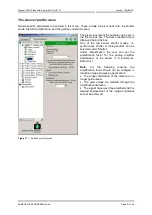
Version 1.08 (04/07)
Manual: CMOS Industrial Camera LOGLUX
i5
Page 6 of 46
KAMERA WERK DRESDEN GmbH
The dynamic (contrast) range of the IBIS5 sensor
In contrast to, say, CMOS sensors for multimedia applications, the IBIS5 has a very wide dynamic
(contrast) range. This parameter describes the sensor's capability to show both very bright and very
dark image parts in the active frame. The figure shows a CD ROM whose surface is diagonally lit by a
lamp from the front, with the LOGLUX
i5 CL set for a normal (approx. 67dB) and extended (approx.
100dB) contrast range, respectively.
Figure 4 :
Example of a very high
image contrast range
In the photo on the left side, neither the manufacturer's name nor the storage capacity nor the
maximum write speed can be read. On the right side, this information can be read without difficulty,
provided the printing quality is good. The photos were taken with the same overall integration time
(approx. 39ms).
Two dynamic ranges can be set on the IBIS5 sensor. In the first range of approx. 67dB, the sensor
exhibits an almost linear transmission function. The operating mode of the sensor is termed
single
integration slope mode
:
In the inactive state - the
shutter
of the sensor is 'closed' - a defined potential, i.e. electrical voltage, is
applied to the individual sensor cell which is shown simplified as a light-sensitive capacitor. When the
sensor shutter is 'opened', the photons hitting the sensor cell cause the potential to die away. When
the sensor shutter is re-closed after a defined time (integration or exposure time), the residual
potential of the sensor cell can be measured and translated into a digital numerical value.
By several successive integrations of the sensor cell potential with respect to time applying different
integration times, the second dynamic range - which is going to be described in more detail here - will
be extended to approximately 100dB. This working mode of the sensor is called
multiple integration
slope mode
and functions as follows:
The basis is the above described
single integration slope mode
. In contrast to it, however, at least one
more integration cycle is carried out in the
multiple integration slope mode
. After the expiry of the first
integration time, an initial potential which is approx. 18% lower than the potential before the first
integration cycle, is applied to the sensor cell. Before a third integration cycle and after the second
integration time, this initial potential is reduced by approx. 34%; and before a fourth integration cycle
and after the third integration time, the initial potential is reduced by approx. 54%.
Before a subsequent integration cycle, the above-mentioned initial potential is applied to those pixels
only which were completely discharged - i.e. over-exposed - in the previous integration cycle. The
residual potentials of all the other pixels are separately added to the residual potentials of the
subsequent integration cycles.
This means that very bright pixels require at least two, in some cases even four integration cycles with
the respective integration potentials and integration times, whereas very dark pixels may 'need' but a
single initial potential in up to four integration times to deliver evaluable residual potentials.







































